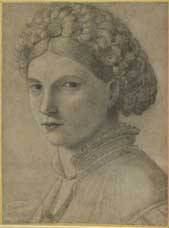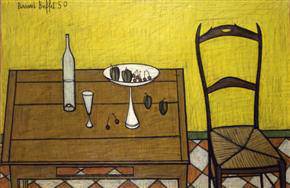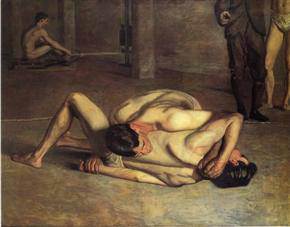
Portrait of a Young Woman, about 1520-1525, attributed to Andrea Previtali.
Black chalk, heightened with white chalk. The J. Paul Getty Museum.
From Line to Light: Renaissance Drawing in Florence and Venice – Getty Museum Italian Renaissance drawings form the core of the Getty Museum’s celebrated drawings collection. On view from July 20 — October 10, 2010, at the Getty Center, From Line to Light: Renaissance Drawing in Florence and Venice brings together spectacular drawings from the Museum’s extensive holdings to explore influential trends in Italian drawing before 1550]]>
Source: Getty Museum
Visitors will have a rare opportunity to examine more than 40 works on paper executed by Italy’s greatest practitioners of drawing, with Raphael (Raffaello Sanzio), Fra Bartolommeo, Andrea del Sarto, and Jacopo Pontormo representing Florence and Rome, and Titian, Vittore Carpaccio, Andrea Mantegna, and Giovanni Bellini representing Venice and the Veneto. The comparative installation provides a greater understanding of the artists’ individual approaches to drawing within the context of their times, against a backdrop of how they each used draftsmanship to solve artistic problems.
“During the Italian Renaissance, drawing evolved into a respected art form in its own right,” said Julian Brooks, associate curator of Drawings, the J. Paul Getty Museum. “This exhibition is an exciting opportunity for visitors to explore and compare the principal schools, and to witness the revolutionary techniques that emerged over that vibrant period.”
From 1480 to 1550, drawing came of age, representing a fundamental shift in style and artistic thinking in the use of preparatory drawings on paper. While it began as a means of preserving artistic ideas for the design of paintings and sculpture, drawing then evolved from a part of the design process to an esteemed independent activity. By 1550 the writer-artist Giorgio Vasari could declare drawing the “father of the arts.”
Artistic strides were made in different Italian regions and cities: The central Italian school, represented by Florence and Rome, focused on the study of the human figure through life drawing and the detailed examination of nature, while the practitioners of the northern Italian school, with Venice as the dominant artistic center, concentrated on the search for tonal and coloristic effects, embracing the use of blue paper and the keen study of light and composition.
Among the highlights in From Line to Light: Renaissance Drawing in Florence and Venice are Nude Man Carrying a Rudder on His Shoulder (15551556), a masterful drawing by Titian, using the blue paper that artists in Venice so often favored; Fra Bartolommeos Madonna and Child with Saints (15101513), an intricate black-and-white chalk drawing that was a design for an important painted altarpiece, and Raphaels Christ in Glory (15191520), in which he worked with a live model and used a range of techniques to draw the figure using black chalk and gray wash, heightened with white chalk on a pale gray prepared paper.
Follow us on:


